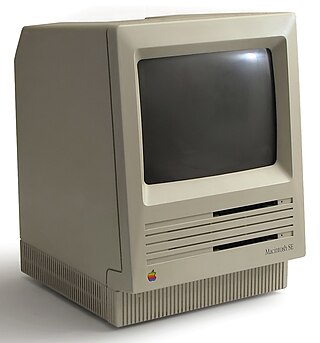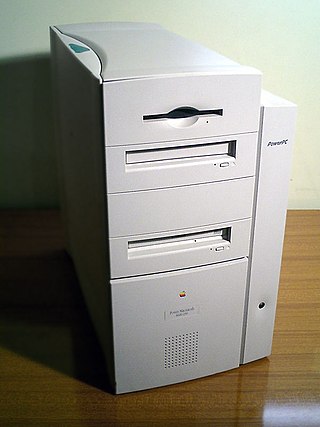
The Power Macintosh, later Power Mac, is a family of personal computers designed, manufactured, and sold by Apple Computer, Inc as the core of the Macintosh brand from March 1994 until August 2006.

The PowerBook is a family of Macintosh laptop computers designed, manufactured and sold by Apple Computer from 1991 to 2006. During its lifetime, the PowerBook went through several major revisions and redesigns, often being the first to incorporate features that would later become standard in competing laptops. The PowerBook line was targeted at the professional market. In 1999, the line was supplemented by the home and education-focused iBook family.

iBook is a line of laptop computers designed, manufactured, and sold by Apple Computer from 1999 to 2006. The line targeted entry-level, consumer and education markets, with lower specifications and prices than the PowerBook, Apple's higher-end line of laptop computers. It was the first mass consumer product to offer Wi-Fi network connectivity, which was then branded by Apple as AirPort.

The Power Macintosh G3 is a series of personal computers designed, manufactured, and sold by Apple Computer from November 1997 to August 1999. It represented Apple's first step towards eliminating redundancy and complexity in the product line by replacing eight Power Macintosh models with three: Desktop and Mini Tower models for professional and home use, and an all-in-one model for education. The introduction of the Desktop and Mini Tower models coincided with Apple starting to sell build-to-order Macs directly from its web site in an online store, which was unusual for the time as Dell was the only major computer manufacturer doing this. Apple's move to build-to-order sales of the Power Macintosh G3 also coincided with the acquisition of Power Computing Corporation, which had been providing telephone sales of Macintosh clones for more than two years.

The Macintosh SE is a personal computer designed, manufactured, and sold by Apple Computer, from March 1987 to October 1990. It marked a significant improvement on the Macintosh Plus design and was introduced by Apple at the same time as the Macintosh II.

The Macintosh IIcx is a personal computer designed, manufactured and sold by Apple Computer, Inc. from March 1989 to March 1991. Introduced six months after the Macintosh IIx, the IIcx resembles the IIx and provides the same performance, but is seven inches narrower, ten pounds lighter, and quieter due to a smaller internal fan. The relative compactness results in three NuBus slots being available, compared with six on the IIx.

The PowerBook G3 is a series of laptop Macintosh personal computers designed, manufactured, and sold by Apple Computer from 1997 to 2001. It was the first laptop to use the PowerPC G3 (PPC740/750) series of microprocessors, and was marketed as the fastest laptop in the world for its entire production run. The PowerBook G3 was succeeded by the PowerBook G4.

The Macintosh Classic II is a personal computer designed and manufactured by Apple Computer, Inc. from October 1991 to September 1993. The system has a compact, appliance design with an integrated 9" monitor, typical of the earliest of the Macintosh range. A carrying handle moulded into the case added a degree of portability at a time when laptops were still relatively uncommon.

The Power Macintosh 7500 is a personal computer designed, manufactured and sold by Apple Computer from August 1995 to May 1996. The 7500 was introduced alongside the Power Macintosh 7200 and 8500 at the 1995 MacWorld Expo in Boston. Apple referred to these machines collectively as the "Power Surge" line, communicating that these machines offered a significant speed improvement over its predecessors. The 7500 introduced a new case design, later dubbed "Outrigger" by Mac enthusiasts. There were two derivative models: the Power Macintosh 7600, identical to the 7500 except for the CPU which was a PowerPC 604 or 604e processor instead of the 7500's 601; and the Power Macintosh 7300, identical to the 7600 but without the video inputs found in both the 7500 and 7600.
Outbound Systems, Inc., was an American computer company based in Boulder, Colorado. Founded by Warren Conner in 1989, the company offered Macintosh clone computer systems in various portable form factors between 1989 and 1991. It left the Mac conversion business in 1992 to build Windows-based desktop computers before going bankrupt in 1993.

The Power Macintosh 7600 is a personal computer designed, manufactured and sold by Apple Computer from April 1996 to November 1997. It is identical to the Power Macintosh 7500, but with a PowerPC 604 CPU. Three models were available with 120 MHz, 132 MHz and 200 MHz processors. Like the 7500, it includes advanced Audio-Video ports including RCA audio in and out, S-Video in, composite video in and standard Apple video ports. The 7600 features the easy-access "outrigger" desktop case first introduced with the Power Macintosh 7500. It was eventually replaced by the Power Macintosh 7300, one of the very few times that Apple updated a computer but gave it a lower model number - the reason is that the 7300 was a joint replacement for the 7600 and the Power Macintosh 7200.
The Apple Network Server (ANS) was a line of PowerPC-based server computers designed, manufactured and sold by Apple Computer, Inc. from February 1996 to April 1997. It was codenamed "Shiner" and originally consisted of two models, the Network Server 500/132 and the Network Server 700/150, which got a companion model, the Network Server 700/200 with a faster CPU in November 1996.

The Power Macintosh 4400 is a personal computer designed, manufactured and sold by Apple Computer, Inc. from November 1996 to February 1998. It differs from prior desktop Macintosh models in that it was built with industry-standard components such as an IDE hard drive and an ATX-like power supply.

The Power Macintosh 6200 is a series of personal computers designed, manufactured, and sold by Apple Computer from May 1995 to July 1997. The 6200 is the PowerPC-based replacement for the Quadra 630, with the same form factor and price range. In early 1997, the rather different Power Macintosh 6300/160 / Performa 6360 based on the Power Macintosh 6400 was introduced. The whole line was discontinued when the desktop model of the Power Macintosh G3 was released.

The Power Macintosh 8600 is a personal computer designed, manufactured, and sold by Apple Computer from February 1997 to February 1998. It was introduced alongside the Power Macintosh 7300 and 9600 with a 200 MHz PowerPC 604e processor, and comes in a new case design that replaces the widely-disliked Quadra 800-based form factor of its predecessor, the Power Macintosh 8500.

The Power Macintosh 7300 is a personal computer designed, manufactured and sold by Apple Computer from February 1997 to November 1997. It was introduced with 166, 180 and 200 MHz CPUs in February 1997 alongside the Power Macintosh 8600 and 9600. The 7300 replaced both the Power Macintosh 7200 and 7600, replacing the only remaining first-generation PowerPC system in Apple's lineup.

The Power Macintosh 7200 is a personal computer designed, manufactured, and sold by Apple Computer from August 1995 to February 1997. The 90 MHz model was sold in Japan as the Power Macintosh 7215, and the 120 MHz model with bundled server software as the Apple Workgroup Server 7250. When sold as the 8200, it used the Quadra 800/Power Mac 8100's mini-tower form factor.

The Power Macintosh 9600 is a personal computer that is a part of Apple Computer's Power Macintosh series of Macintosh computers. It was introduced in February 1997 alongside the Power Macintosh 7300 and 8600, and replaced the Power Macintosh 9500 as Apple's flagship desktop computer.

The Power Macintosh 6500 is a personal computer designed, manufactured and sold by Apple Computer from February 1997 to March 1998 as part of the Power Macintosh family. It was introduced with speeds of 225 and 250 MHz, with two faster models at 275 and 300 MHz being added a couple of months later.

The Power Macintosh 5200 LC and Power Macintosh 5300 LC are a line of personal computers that were a part of Apple Computer's Power Macintosh, LC, and Performa families of Macintosh computers. It was mainly sold in the North American education market. When it was sold to the consumer market, they were marketed as the Performa 5200 and Performa 5300.


















